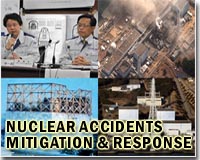| . |  |
. |
Tokyo (AFP) May 5, 2011 Workers on Thursday entered a reactor building at Japan's Fukushima nuclear plant for the first time since an explosion hit the facility, a day after the March 11 tsunami and quake. Here is how the nuclear crisis unfolded: March 11, 2011: A 9.0-magnitude undersea earthquake strikes off the northeast coast, triggering a massive tsunami which destroys whole towns and villages. The power supply and cooling systems at the Fukushima Daiichi nuclear power plant 250 kilometres (155 miles) north of Tokyo are damaged. March 12: The government orders the evacuation of residents living near the plant, where an explosion occurs in a building housing one of the reactors. On March 14 a second explosion occurs, while on March 15 two more blasts and a fire rock the plant and radiation levels reach dangerous levels. March 18: The core of the number three reactor is damaged, sparking a race against time to cool down the reactors and prevent nuclear meltdown. March 21: Japan orders a halt to shipments of certain foods from four prefectures after abnormal radiation levels are detected in products from the area. March 29: "Maximum alert" issued after plutonium is discovered in the soil. March 31: Radioactivity detected in groundwater reaches a new high of 4,385 times the legal limit. April 2: Radioactive water leaks into the sea from a crack in the damaged nuclear plant. April 4: Start of operations to dump 11,500 tonnes of radioactive water into the sea. April 6: The radioactive water leak at the plant is plugged. April 7: Plant operator Tokyo Electric Power Co starts injecting nitrogen into the number one reactor of the Fukushima plant to prevent a hydrogen explosion. April 11: The government says it will widen the evacuation zone around the plant because of long-term health concerns. April 12: Japan upgrades its assessment of the severity of the nuclear emergency to a maximum seven on an international scale. April 17: TEPCO says it expects to cool reactors and control the radiation within six to nine months. April 21: Japan declares the 20-kilometre (12-mile) evacuation area around the plant a legal no-entry zone. May 5: Workers enter a reactor building at the plant for the first time since an explosion at the facility.
Share This Article With Planet Earth
Related Links Bringing Order To A World Of Disasters A world of storm and tempest When the Earth Quakes
 Workers enter reactor building at Japan nuclear plant
Workers enter reactor building at Japan nuclear plantTokyo (AFP) May 5, 2011 Workers entered a reactor building at Japan's stricken nuclear plant Thursday for the first time since an explosion hit the facility a day after the March 11 earthquake and tsunami, officials said. Wearing gas masks and protective suits with oxygen tanks on their backs, two workers stepped into the building housing reactor number one - one of four reactors badly damaged at the Fukushima Dai ... read more |
|
| The content herein, unless otherwise known to be public domain, are Copyright 1995-2010 - SpaceDaily. AFP and UPI Wire Stories are copyright Agence France-Presse and United Press International. ESA Portal Reports are copyright European Space Agency. All NASA sourced material is public domain. Additional copyrights may apply in whole or part to other bona fide parties. Advertising does not imply endorsement,agreement or approval of any opinions, statements or information provided by SpaceDaily on any Web page published or hosted by SpaceDaily. Privacy Statement |